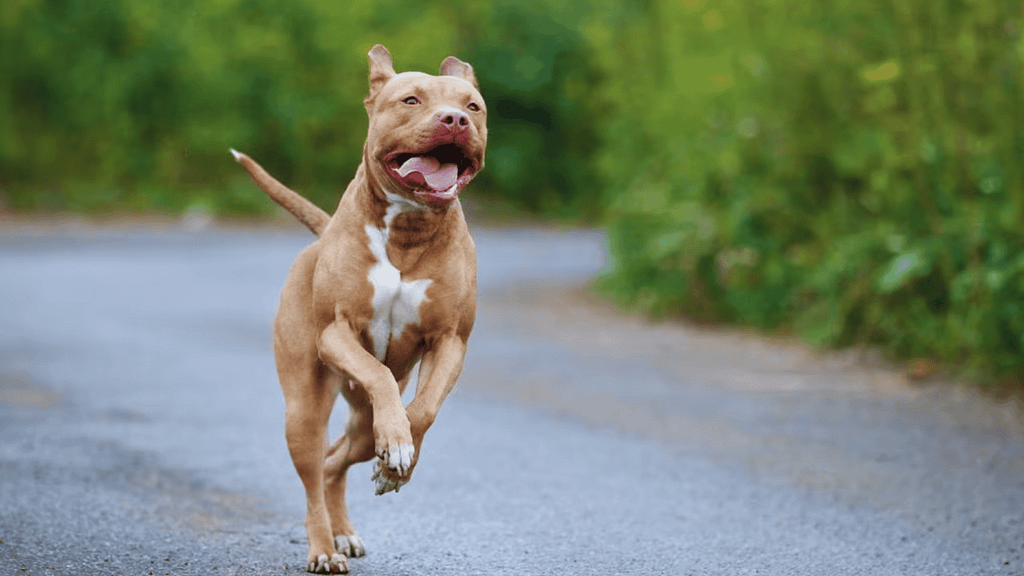Get 100+ Funny Animal Videos Free
Having a dog can be rewarding, but knowing the type of dog you’re getting is vital before you bring it home. You might wonder if you are thinking about “What are The Most Aggressive Breeds of Dogs?” because you want your pet to be happy and safe.
Finding the right dog is a big deal; we’re here to support you.
Different factors such as genetics, upbringing, and individual personality can affect aggressive behavior in dogs.
While people may have certain perceptions about dog breeds and their tendencies, the reality is more complex. Several factors can influence the possibility of a breed being assertive.
Why It’s Important to Understand What Are The Most Aggressive Breeds of Dogs?
Understanding the most aggressive dog breeds is important for promoting responsible dog ownership and ensuring everyone feels safe around dogs.
It helps us care for and build good relationships with our furry friends. Knowing which breeds might need extra attention and training can create a safer and more loving environment for dogs and people.
It’s also important to remember that every dog is unique, and factors like how they’re raised and their surroundings play a significant role in their behavior.
So, let’s work together to understand and support our canine companions, ensuring they feel happy and loved while keeping everyone safe.
Top 5 The Most Aggressive Dog Breeds In The World
You may be interested in Knowing the Most Aggressive Dog Breeds. It’s important to recognize that every dog has a unique personality.
Five dog breeds that are often considered to have more aggressive tendencies:
- Pit Bull Terrier
- Rottweiler
- German Shepherd
- Doberman Pinscher
- Bullmastiff
It’s also important to be aware of certain breeds requiring more training and socialization to ensure their behavior is safe and appropriate. With that in mind, here is a list of dog breeds known for their potential for aggression.
Pit Bull Terrier

Unfortunately, the Pit Bull Terrier is often regarded as one of the most aggressive dog breeds, stirring intense debates and sparking controversy.
While they have a muscular build and tenacious demeanor, Pit Bulls are not inherently aggressive.
Understandably, media sensationalism and anecdotal accounts have fueled their reputation, but we must approach these dogs with empathy and understanding.
Considering various factors when discussing Pit Bulls and their behavior is essential. While some may demonstrate aggression, it’s crucial to recognize that each dog’s temperament can differ significantly within the breed.
| Breed Name | Pit Bull Terrier |
|---|---|
| Size | Medium to Large |
| Weight | 30 to 85 pounds (male), 30 to 75 pounds (female) |
| Height | 17 to 21 inches (male), 17 to 20 inches (female) |
| Lifespan | 12 to 16 years |
| Temperament | Affectionate, loyal, energetic; may exhibit aggression |
| Coat | Short and smooth |
| Colors | Various, including brindle, black, blue, and fawn |
| Exercise Needs | High |
| Trainability | Intelligent, responds well to positive reinforcement |
| Socialization | Important to prevent aggressive behavior |
| Common Health Issues | Hip dysplasia, allergies, skin conditions, and heart disease |
Pit Bulls’ behavior is shaped by genetics, upbringing, socialization, and environment. Many pit Bulls are loving and well-behaved family pets, and blanket statements about the breed ignore this fact.
Understanding Pit Bulls and aggression requires a balanced perspective that promotes responsible ownership and compassionate treatment of all dogs.
Rottweiler

Rottweilers are often considered aggressive breeds due to their muscular build and protective instincts. While they are known for their loyalty and confidence, they can exhibit aggression if not trained or socialized properly.
It is crucial to acknowledge that owning this breed requires excellent responsibility and diligent training due to its natural guarding instincts, strength, and size. Doing so can prevent potential aggressive behaviors, and you can enjoy a loyal and well-behaved companion.
| Breed Name | Rottweiler |
|---|---|
| Size | Large |
| Weight | 95 to 135 pounds (male), 80 to 100 pounds (female) |
| Height | 24 to 27 inches (male), 22 to 25 inches (female) |
| Lifespan | 9 to 10 years |
| Temperament | Confident, loyal, protective; may exhibit aggression |
| Coat | Short, dense, and double-coated |
| Crucial to prevent aggressive behaviour | Black with rust or mahogany markings |
| Exercise Needs | High |
| Trainability | Intelligent, needs firm and consistent training |
| Socialization | Crucial to prevent aggressive behavior |
| Common Health Issues | Hip and elbow dysplasia, heart conditions, and certain cancers |
It’s important to note that Rottweilers can have different personalities, even within the same breed. Many Rottweilers can make great companions if raised in a loving environment.
Responsible ownership practices, education, and training are crucial in enabling positive interactions between Rottweilers and the community. To achieve this, it is essential to understand the complexities surrounding Rottweilers and aggression.
German Shepherd

The German Shepherd is a versatile and intelligent dog breed. It is also loyal, trainable, and protective.
It is expected that dogs will be used in various roles, such as police K-9 units, search and rescue, and service dogs. However, there is a debate surrounding their reputation for aggression.
Like any breed, German Shepherds can display aggressive behaviors if they are not adequately trained or socialized, feel threatened, or are inadequately managed.
| Breed Name | German Shepherd |
|---|---|
| Size | Medium to Large |
| Weight | 50 to 90 pounds (male), 45 to 70 pounds (female) |
| Height | 24 to 26 inches (male), 22 to 24 inches (female) |
| Lifespan | 9 to 13 years |
| Crucial to prevent aggressive behavior | Intelligent, loyal, protective; may exhibit aggression |
| Coat | Double coat, medium-length, dense, and straight |
| Vital to prevent aggressive behavior | Most commonly black and tan, but also sable and all black |
| Exercise Needs | High |
| Trainability | Highly trainable, responsive to positive reinforcement |
| Socialization | Crucial to prevent aggressive behavior |
| Common Health Issues | Hip and elbow dysplasia, bloat, and degenerative myelopathy |
Understanding the intricacies of the German Shepherd breed, including their temperament and
When raised in loving and structured environments, German Shepherds typically exhibit calm and confident demeanors, making them loyal and affectionate family companions.
Understanding the nuances of this breed, including their potential for aggression, highlights the importance of responsible ownership, proper training, and early socialization to ensure that German Shepherds can thrive as valued members of the community.
Doberman Pinscher

The Doberman Pinscher is often labeled as one of the most aggressive dog breeds, primarily due to its imposing stature and reputation as a guard dog. However, it’s crucial to approach this assertion with nuance and understanding.
While Doberman Pinschers possess traits such as loyalty, intelligence, and alertness, which make them excellent guard dogs, aggression is not inherent in this breed. Like any dog, a Doberman’s behavior is shaped by socialization, training, and individual temperament.
Hey there! If you’re considering getting a Doberman Pinscher, I’m here to tell you that they can make amazing companions. These pups are known for their affectionate and loyal personalities. With some love and proper training, they can be well-behaved and obedient pets.
| Breed Name | Doberman Pinscher |
|---|---|
| Size | Large |
| Weight | 75 to 100 pounds (male), 60 to 90 pounds (female) |
| Height | 26 to 28 inches (male), 24 to 26 inches (female) |
| Lifespan | 10 to 12 years |
| Temperament | Intelligent, loyal, alert; may exhibit aggression |
| Coat | Short, smooth, and thick |
| Crucial to prevent aggressive behaviour | Black, red, blue, and fawn |
| Exercise Needs | High |
| Trainability | Highly trainable, responds well to consistent training |
| Socialization | Crucial to prevent aggressive behavior |
| Common Health Issues | Dilated cardiomyopathy, von Willebrand’s disease, hip dysplasia |
Doberman Pinschers are often known for being protective. However, with the proper techniques and responsible ownership, they can become the best furry friend you could ever hope for. By raising them in a loving, structured environment with proper training and socialization, these dogs can become affectionate, loyal, and well-behaved companions.
Thus, while the Doberman Pinscher may have a history rooted in protective instincts, responsible ownership, and positive reinforcement techniques can help mitigate potential aggressive tendencies, fostering a harmonious relationship between these dogs and their human companions.
Bullmastiff

The Bullmastiff is a large dog known for its protective nature. Initially bred for guarding, this dog can become aggressive if not properly trained or socialized.
The Bullmastiff is a dog breed intended to protect its territory and discourage intruders. Proper training and socialization are essential to avoid aggressive behavior.
| Breed Name | Bullmastiff |
|---|---|
| Intelligent, respond well to consistent training | Large |
| Weight | 100 to 130 pounds (male), 90 to 120 pounds (female) |
| Height | 25 to 27 inches (male), 24 to 26 inches (female) |
| Lifespan | 8 to 10 years |
| Temperament | Gentle, loyal, protective; may exhibit aggression |
| Coat | Short, dense, and smooth |
| Colors | Brindle, fawn, or red with a black mask |
| Exercise Needs | Moderate to High |
| Trainability | It is essential to prevent aggressive behavior |
| Socialization | Important to prevent aggressive behavior |
| Common Health Issues | Hip dysplasia, bloat, and certain heart conditions |
Bullmastiffs can sometimes display aggressive behavior, but this can be prevented with responsible ownership, early socialization, and consistent training.
Bullmastiffs can make gentle, loyal, and devoted companions when raised in a loving and structured environment.
It is important to remember that good ownership practices and early training are key to ensuring a happy and healthy relationship with your Bullmastiff.
To ensure that Bullmastiffs behave appropriately and become cherished family members, it is possible to use positive reinforcement methods and preventive measures, even though their history is rooted in protection.
Conclusion
As animal lovers, we all want to promote responsible pet ownership and ensure the safety of dogs and people.
One crucial aspect of achieving this goal is understanding the Most Aggressive dog Breeds.
It’s a sensitive topic, but it’s essential to approach it with empathy and compassion for all dogs and their owners.
Important factors when choosing a dog include genetics, upbringing, and personality. Considering these things, you can select the breed best for you and your family.
It’s important to remember that every dog is unique, and various factors can influence their behavior.
While some breeds may have a reputation for being aggressive, it’s important not to assume that all dogs of that breed will behave the same way.
Creating safe and loving environments for dogs and humans involves acknowledging that certain breeds may be prone to aggression.
To address this, proactive measures, such as early socialization, proper training, and a nurturing environment, are important.
The text highlights the need to treat all dogs with compassion, irrespective of their breed, to create a safer and more harmonious world for humans and dogs.









